A girlish face, with an olive complexion and refined features of a purity difficult to find in other works of art. The deep black eyes, which, with a slightly downward gaze, communicate hesitation, lingering, shyness, perhaps even a little discomfort. The lectern, outlined with a precision reminiscent of Flemish painting and sparing no moths on the surface of the wood. And then the hands, tapering, elegant: the right hand makes a forward movement almost as if to screen itself, the left hand tries instead to close the veil to cover the neck, caught in a slight twist, and the robe that leaves a portion of the chest uncovered, tiny but enough to prompt the protagonist to deem it more convenient to cover it. These are the elements that make Antonello da Messina ’sAnnunciata one of the most seductive works in all of art history.
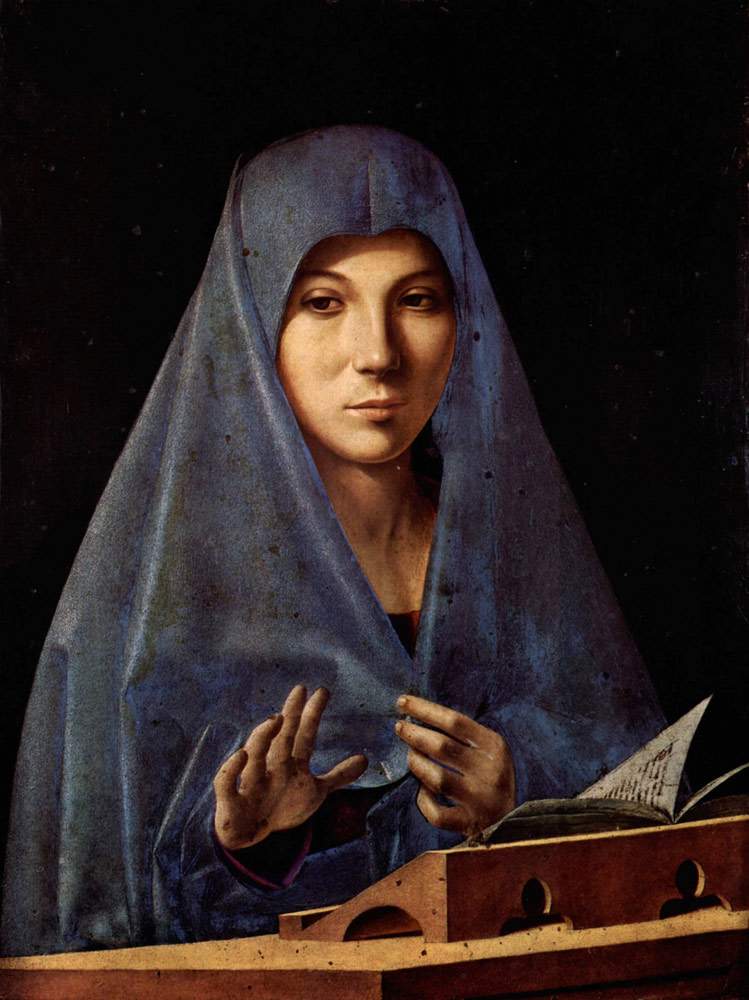 |
| Antonello da Messina, Annunciation (c. 1476; oil on panel, 45 x 34.5 cm; Palermo, Palazzo Abatellis, Regional Gallery) |
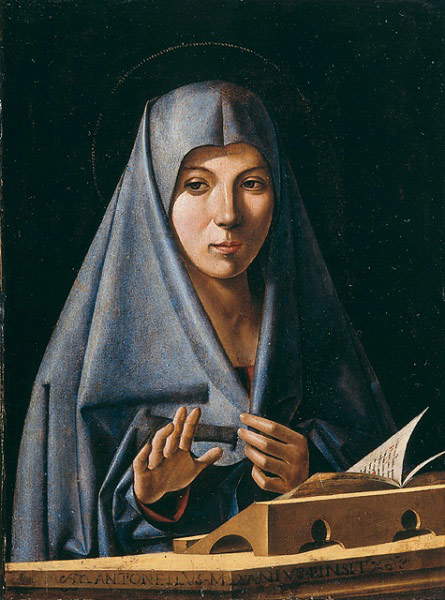 |
| Antonio di Saliba, Annunciation (late 15th century; oil and tempera on panel, 46.8 x 34.7 cm; Venice, Gallerie dell’Accademia) |
The Messina painter’s Madonna is only apparently alone. In fact, Antonello leaves us in a position to perceive the presence of thearchangel Gabriel, who has come to announce to her the birth of Jesus, right in front of her: he is out of the composition because he is in the position in which we who observe the painting find ourselves. Mary has been caught off guard: her hand, reaching forward, almost wants to “block the angel’s message with a surcease of demure surprise but also of questioning,” to use a happy expression by Eugenio Battisti. With that slight movement of her hand, Mary seems to be telling the angel not to proceed further, because she was not prepared for this encounter, and at the same time she wonders what God’s messenger will have to say to her: Antonello has the virtue of translating this complex state of mind into a very simple gesture. The demureness of which Battisti speaks is revealed, as anticipated, by the act of the other hand, which tries in all haste and as quickly as possible to conceal her limbs with the veil (or, to use the exact term, the maphorion, the mantle Mary used to cover her shoulders and head). And despite the swiftness of the action, the Virgin does not flinch; on the contrary: her elegance remains unaffected. Of course, there is artifice as well, for Antonello subjects the entire work to an obvious as well as severe geometric order: the face is inscribed in an oval, the veil forms a triangle, the opening of the veil over the face in turn forms an inverted triangle, the folds fall perpendicular. Despite all this, it is a painting full of life, for the reasons described above: because we are in the beginning stages of an encounter, because a dialogue is about to be established, because the Virgin’s movements are very expressive. And as if that were not enough, there is also a subtle breath of wind that disrupts the pages of the book resting on the lectern: a sign of the arrival of the archangel moving the air around him.
The reading just proposed of theAnnunciation is but one of many that have been proposed for the work. It is, in my opinion, the most suggestive, as well as the one on which there is most agreement among critics, but it should be given that there are those who have tried to interpret Mary’s movements and mimicry in other terms. The gesture of the outstretched right hand, far from being an invention of Antonello, recurs in several earlier Annunciations, and is often interpreted as a sign of acceptance of the destiny that the archangel Gabriel has communicated to Our Lady. In an Annunciation by the Flemish artist Dirck Bouts now in the Getty Museum but first attested in 1810 in the collections of the Foscari family, which belonged to the Venetian patriciate (it cannot therefore be ruled out that it was not in Venice already at the time of Antonello’s stay in the lagoon, between 1474 and 1475), the Virgin stretches out both hands in front of her while the angel, with his index finger pointing, is clearly declaiming the announcement to her: it is obvious that, in such a depiction, the hands indicate the fact that Mary is taking note of the events that have been communicated to her. However, in Antonello, things are made more complicated by the fact that only one of the two hands is brought forward, so that the other may support hypotheses of a different nature.
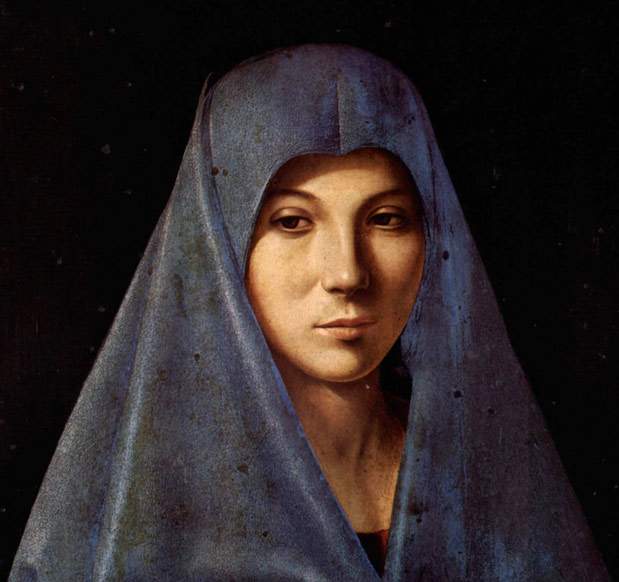 |
| Antonello da Messina, Annunciation, Detail of the Face |
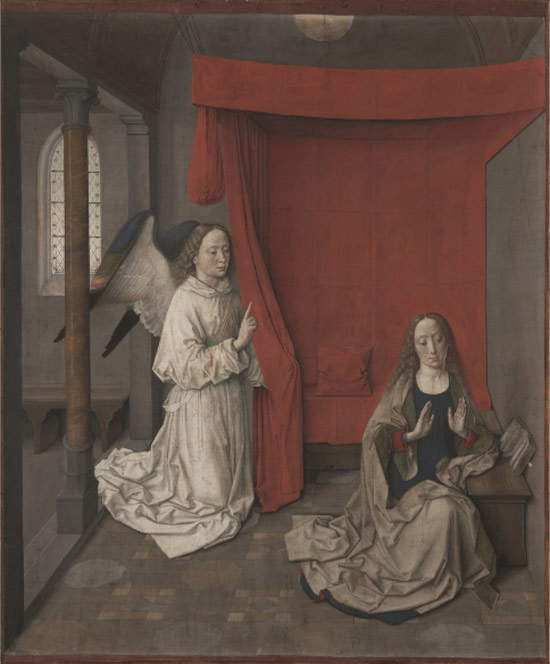 |
| Dirck Bouts, Annunciation (c. 1450-1455; tempera on canvas, 90 x 74.6 cm; Malibu, Getty Museum) |
Three years ago, a Sicilian scholar, Giovanni Taormina, proposed a new interpretation, also in light of the fact that the book in front of the Annunciation may be a manuscript with the Magnificat (in fact, a capital “M” can be glimpsed at the beginning of the page lifted by the wind). It is also worth mentioning because one of Antonello’s leading scholars, Mauro Lucco, had the role of “presenter” at the conference during which Taormina presented his study. The title, The Mystery Unveiled, is certainly not one that is best suited to an art history study, because of its mix of pretentiousness (since nothing has been revealed: it is a hypothesis) and that esotericism that makes any very normal iconological question appear as a “mystery,” but the contents are interesting. Taormina starts from the assumption that the “M” mentioned is an M in oncial script (a type of writing with full and sinuous shapes, much used in medieval manuscripts especially in the Mediterranean area), whose roundness would refer to the circle understood as a symbol of perfection: clues that suggest that that letter indicates precisely the beginning of the Magnificat, the prayer that, according to Luke’s Gospel, Mary raises to God during the meeting with her cousin Elizabeth, an episode following the moment of the Annunciation. In the Gospel it is said that during the encounter “Elizabeth was filled with the Holy Spirit”: Taormina argues that the Magnificat present in the book is a clue that reveals, in the painting, the presence of the Holy Spirit manifesting itself in the form of the wind that lifts the pages (also in accordance with the etymological root of the term “Spirit”: just think of the verb “to breathe out,” not to mention the terms in Greek and Hebrew with which the word “Spirit” is expressed and which all have to do with the concepts of wind, breath, breath). Moreover, the smile hinted at by the Virgin’s mouth clashes with any motion of surprise suggested by the hands: Antonello, if he had wanted to communicate the feeling of surprise, should have painted a more coherent expression on the Madonna’s face. It would therefore be a pose intended to communicate awareness. If the hypothesis were true, Antonello would have effectively reinvented an iconography.
Whether one wants to consider the above hypothesis convincing or not, there is one point on which Taormina agrees with all critics: theAnnunciation by Antonello is the result of a precise geometric order, as mentioned above. One senses the lesson of Piero della Francesca, an author whom Antonello knew well, and from whom he takes the tendency to regulate the composition according to, precisely, well-defined geometric principles, and to frame his scenes in rigorous perspective settings. The clue considered by many to be most revealing of Antonello’s updating of the conquests of perspective is precisely the right hand depicted in an admirable and sophisticated foreshortening that refers directly to Piero’s art, as Roberto Longhi already noted in 1914, relating the hand of theAnnunciation to that of the lady who appears behind the Queen of Sheba in the fresco with theAdoration of the Sacred Wood and the Encounter with King Solomon that the Tuscan painter had included in the celebrated Stories of the True Cross in the church of San Francesco in Arezzo. Longhi first provided a splendid description of the hand: “the right hand moves forward inclined to cautiously attempt the possible limit of the volume; having found it, it stops, while, opposed to it, the book raises on the air the sharp slash of its candid sheet.” And then he went on to locate the references: “without the sloping hand flattened with shadow and light of the lady behind the head of Queen Saba, by the bridge, the hand of the Annunciata of Palermo, the most beautiful hand I know in art, would not have existed.” A hand that, therefore, also serves to create a space between the Annunciata and us: the gesture makes us tangibly aware of the distance that separates the Annunciata from us and helps to make us even more aware of that dual role that Antonello invites us to assume and of which the English art historian John Shearman had spoken in 1992: in fact, ours can be the angel’s point of view or that of mere spectators of the scene.
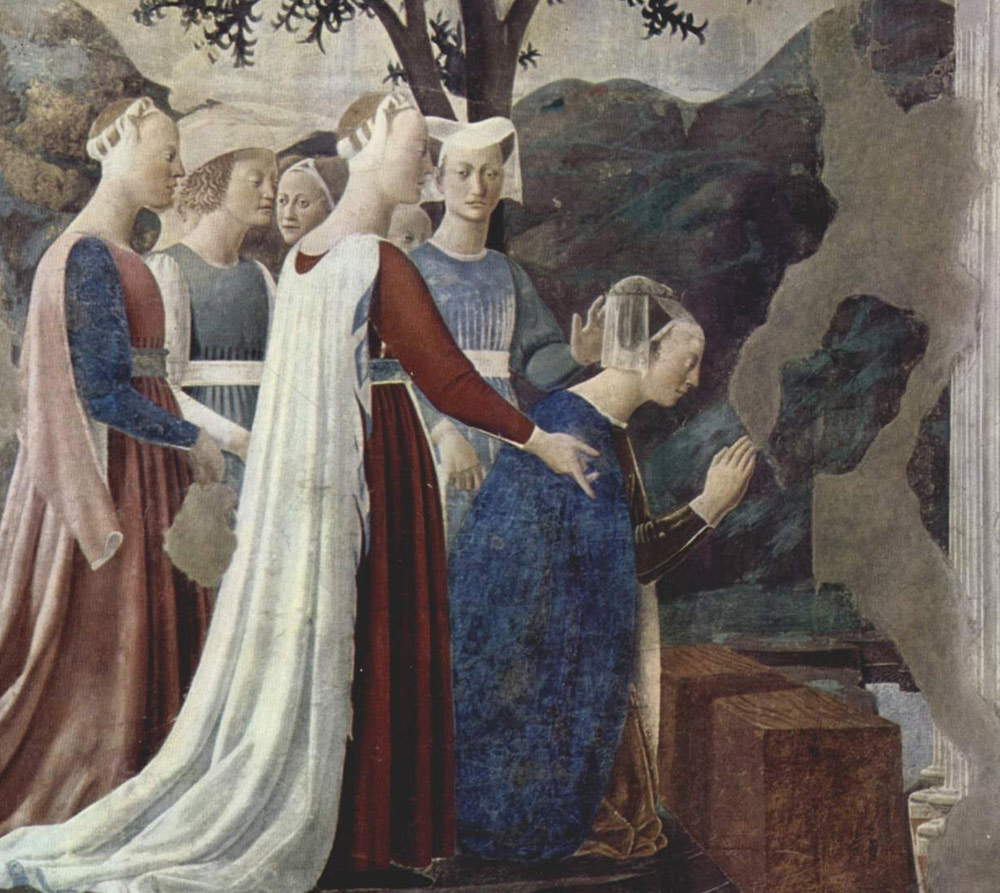 |
| Piero della Francesca, Adoration of the Sacred Wood and Meeting of Solomon and the Queen of Sheba, detail (1452-1458; fresco, 336 x 747 cm; Arezzo, San Francesco) |
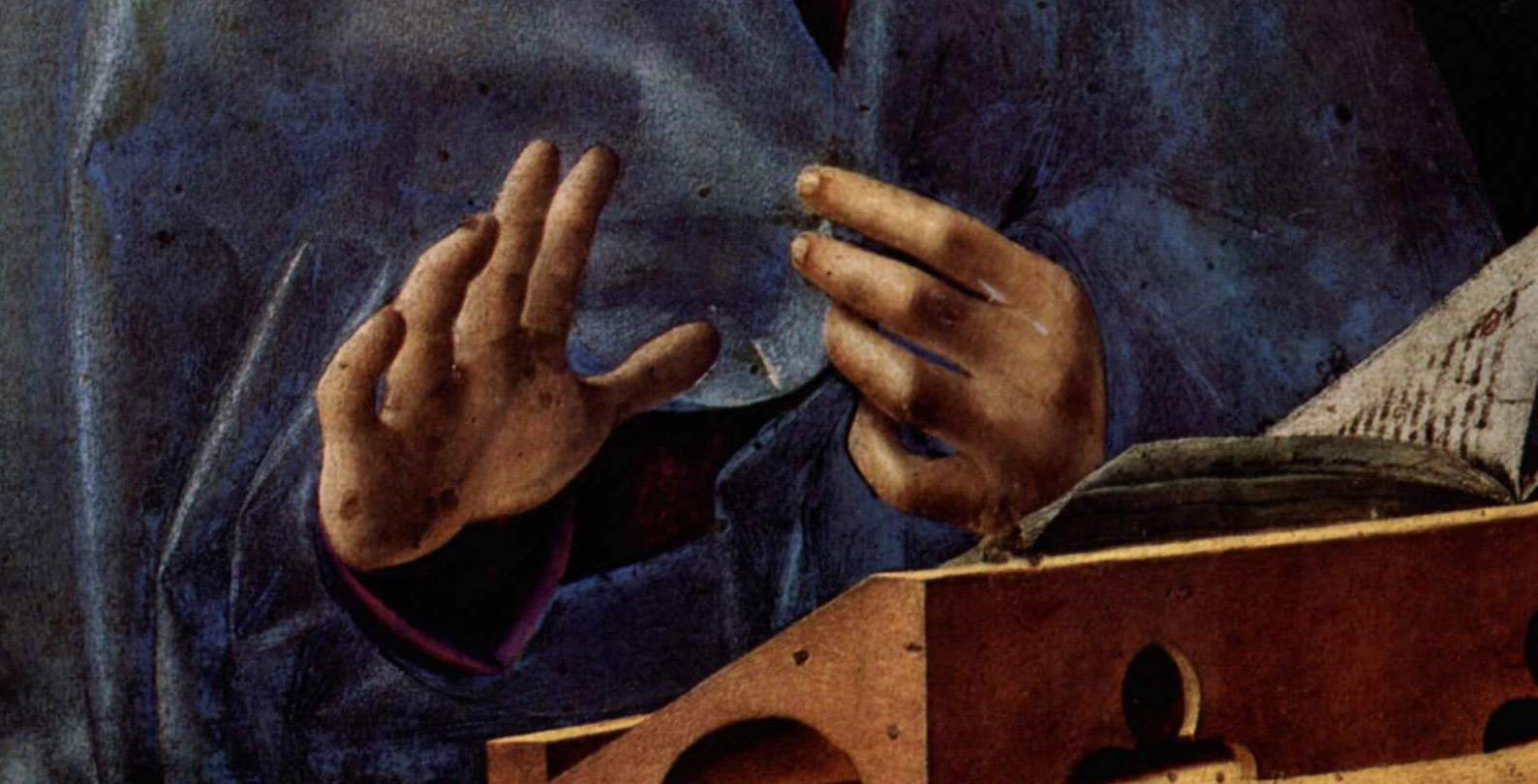 |
| Antonello da Messina, Annunciation, detail of hands |
| The Byzantine icon in the Cathedral of Fermo |
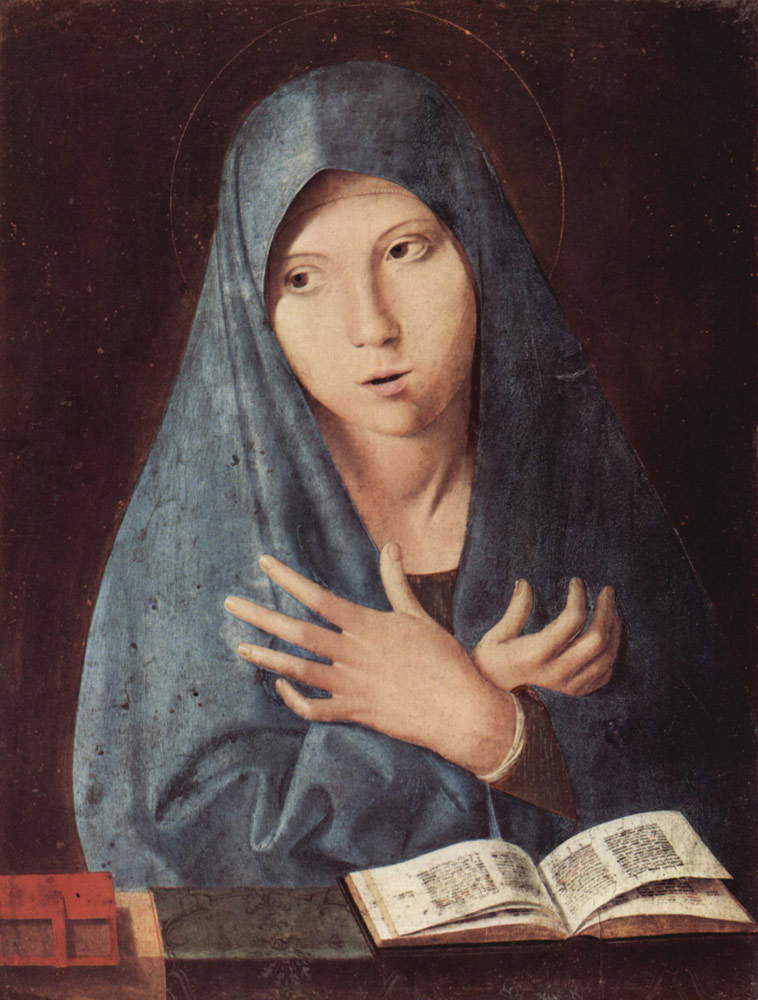 |
| Antonello da Messina, Annunciation (c. 1474-1475; oil on panel, 43 x 32 cm; Munich, Alte Pinakothek) |
TheAnnunciata in Palermo is the final stage of Antonello’s revolution. The viewer’s involvement here is greater than in the Munich panel counterpart. The painter has removed the parapet that created a physical boundary between us and the Virgin. The gestures and mental disposition, Collareta again notes, show openness to the outside world, barriers between the space of the painting and the real space are removed, there is continuity between Mary’s movements, her inner upheaval, and our relationship with her. To put it briefly: it is an extremely modern painting, marking a milestone in the history of Western art. And, at the risk of being trite, it can be said that Antonello da Messina’sAnnunciation is a painting of disarming beauty. His Virgin is beautiful because she is pure but at the same time earthly, ethereal and natural, solemn but close and palpitating. A work that, as Gioacchino Barbera has well written, “is astonishing in its ability to represent, with such convincing sense of volume and perspective, a type of idealized Mediterranean beauty in an image that is simultaneously abstract and realistic.”
Reference Bibliography
Warning: the translation into English of the original Italian article was created using automatic tools. We undertake to review all articles, but we do not guarantee the total absence of inaccuracies in the translation due to the program. You can find the original by clicking on the ITA button. If you find any mistake,please contact us.